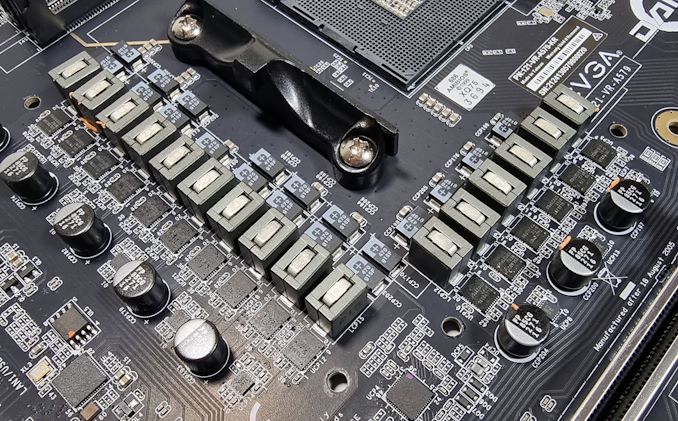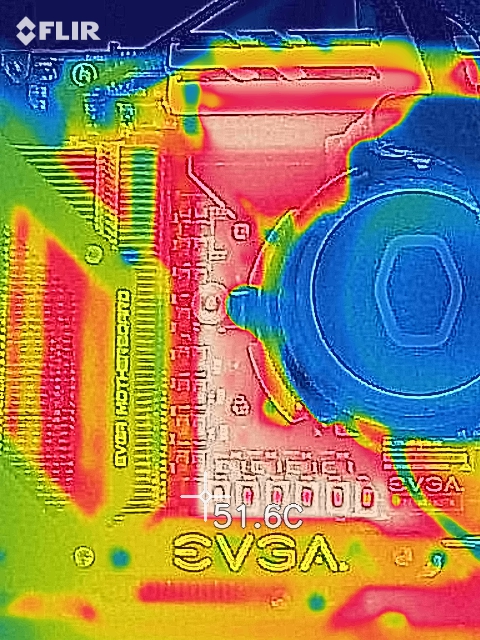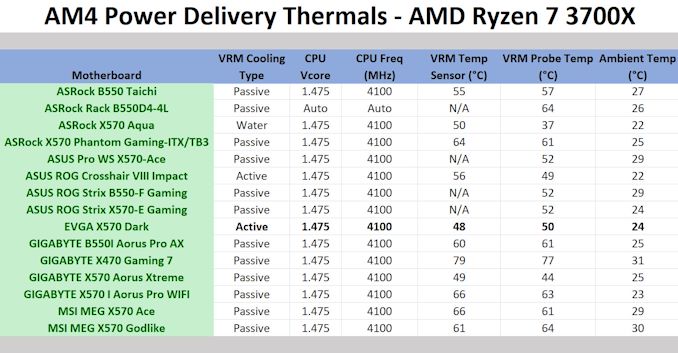The EVGA X570 Dark Motherboard Review: A Dark Beast For Ryzen
by Gavin Bonshor on October 8, 2021 8:00 AM ESTPower Delivery Thermal Analysis
One of the most requested elements of our motherboard reviews revolves around the power delivery and its componentry. Aside from the quality of the components and its capability for overclocking to push out higher clock speeds which in turn improves performance, is the thermal capability of the cooling solutions implemented by manufacturers. While almost always fine for users running processors at default settings, the cooling capability of the VRMs isn't something that users should worry too much about, but for those looking to squeeze out extra performance from the CPU via overclocking, this puts extra pressure on the power delivery and in turn, generates extra heat. This is why more premium models often include heatsinks on its models with better cooling designs, heftier chunks of metal, and in some cases, even with water blocks.

The 17-phase (14+2+1) power delivery operating at 7+1+1 on the EVGA X570 Dark
Testing Methodology
Out method of testing out if the power delivery and its heatsink are effective at dissipating heat, is by running an intensely heavy CPU workload for a prolonged method of time. We apply an overclock which is deemed safe and at the maximum that the silicon on our AMD Ryzen 7 3700X processor allows. We then run the Prime95 with AVX2 enabled under a torture test for an hour at the maximum stable overclock we can which puts insane pressure on the processor. We collect our data via three different methods which include the following:
- Taking a thermal image from a birds-eye view after an hour with a Flir Pro thermal imaging camera
- Securing two probes on to the rear of the PCB, right underneath CPU VCore section of the power delivery for better parity in case the first probe reports a faulty reading
- Taking a reading of the VRM temperature from the sensor reading within the HWInfo monitoring application
The reason for using three different methods is that some sensors can read inaccurate temperatures, which can give very erratic results for users looking to gauge whether an overclock is too much pressure for the power delivery handle. With using a probe on the rear, it can also show the efficiency of the power stages and heatsinks as a wide margin between the probe and sensor temperature can show that the heatsink is dissipating heat and that the design is working, or that the internal sensor is massively wrong. To ensure our probe was accurate before testing, I binned 10 and selected the most accurate (within 1c of the actual temperature) for better parity in our testing.
For thermal image, we use a Flir One camera as it gives a good indication of where the heat is generated around the socket area, as some designs use different configurations and an evenly spread power delivery with good components will usually generate less heat. Manufacturers who use inefficient heatsinks and cheap out on power delivery components should run hotter than those who have invested. Of course, a $700 flagship motherboard is likely to outperform a cheaper $100 model under the same testing conditions, but it is still worth testing to see which vendors are doing things correctly.
Thermal Analysis Results

We measured 51.6°C on the hottest part of the CPU socket during our testing
The EVGA X570 Dark is using a large 17-phase power delivery which is running with a 14+2+1 design. The CPU section is operating with fourteen Intersil ISL99390 90 A smart power stages which are doubled up with seven Intersil ISL6617A doublers, while the SoC using is using two of the same 90A power stages with one ISL6617A doubler. The other power stage is operating the memory and is operating separately from the rest. With the design using doublers, the Renesas RAA22904 PWM controller is operating in a 7+1 configuration. Keeping the power delivery cool is a large dual heatsink array with large finned areas designed to catch passive airflow, with a large single heat pipe connecting both the VRM heatsinks with the chipset heatsink. The power delivery section also includes two small cooling fans which make this design an active one.
Focusing on the results, the EVGA X570 Dark performed fantastically in our VRM thermal testing. While the board doesn't currently work with HWInfo in terms of temperature monitoring, the firmware allows users to use the dual two-digit LED debugger to readout from the integrated VRM thermal sensor. We saw a maximum of 48°C from this during our testing, with a maximum temperature of 50°C from our K-type thermocouple attached to the rear of the power delivery.
This puts the X570 Dark as one of the most comprehensively cooled power deliveries we've tested on AM4, with better performance than the water-cooled ASRock X570 Aqua; impressive.











36 Comments
View All Comments
Unashamed_unoriginal_username_x86 - Friday, October 8, 2021 - link
The 7-zip compression lead of 8.5% is very impressive... I think? However, the poor interrupt performance is concerning... Maybe...I'm glad it has 2x2x7 segment displays, that makes a perfect number which bodes well.
either way, this is definitely going to be one of the best clockers out there, so Rolex better 'watch' out. The EVGA® X570 Dark is now my go to recommendation if you really want good, money-no-object 7-Zip performance but you also really like the 3700x.
shabby - Friday, October 8, 2021 - link
$690 board that can only transfer ~250MB/sec over network... pathetic. What's the deal with the slow network cards? Where are the consumer 10gbit routers/switches?shabby - Friday, October 8, 2021 - link
And by consumer i mean affordable.gavbon - Friday, October 8, 2021 - link
The caveat is, extreme overclockers aren't bothered by network transfer speeds. Sure, it would have been better if they did include a 10 GbE controller for argument's sake, but it does nothing for the raw compute performance.Daeros - Saturday, October 9, 2021 - link
Yeah, that argument doesn’t hold. If it was really focused on extreme overclocking it wouldn’t have Wi-Fi.Railgun - Saturday, October 9, 2021 - link
There are plentyQasar - Sunday, October 10, 2021 - link
and they are ? my guess, not known brand names, or ones that are not available everywhere. i just checked one store here, and the least expensive one is $350,and it only has two 10g ports, other 8 are gigabit the next, is a eight 10G SFP+ ports, again at $350 + the cost of the SFP+ modules/transceivers. not really affordable to meshabby - Sunday, October 10, 2021 - link
There aren't any and you know it.Railgun - Wednesday, October 13, 2021 - link
Funny. As I’m using some. Unifi has a couple. Mikrotik has more.Qasar - Saturday, October 16, 2021 - link
yep, not well known brand names that are probably only available in certain, or specific markets....if that is your definition of " plenty " then i dont know what to say.